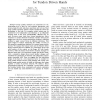Free Online Productivity Tools
i2Speak
i2Symbol
i2OCR
iTex2Img
iWeb2Print
iWeb2Shot
i2Type
iPdf2Split
iPdf2Merge
i2Bopomofo
i2Arabic
i2Style
i2Image
i2PDF
iLatex2Rtf
Sci2ools
87
Voted
IROS
2006
IEEE
2006
IEEE
On the Importance of Asymmetries in Grasp Quality Metrics for Tendon Driven Hands
Abstract— Grasp quality measures are important for understanding how to plan for and maintain appropriate and secure grasps for pick and place operations and tool use. Most grasp quality measures assume certain symmetries about the mechanism or the task. For example, contact points may be considered to be independent and identical, or an ellipsoidal measure such as the force manipulability ellipsoid may be used. However, many tasks have strong asymmetries, where wrenches in certain directions dominate. Tendon driven hand designs may also have strong asymmetries, leading to differing abilities to apply contact forces in different directions. This paper begins to explore empirically the validity of some of the symmetry assumptions employed by common grasp quality metrics. We examine the human hand and the Shadow Robot Hand, and find that force abilities vary with finger choice and with location of the contact on the finger for both hands. However, while the human hand shows dramatic...
| Added | 12 Jun 2010 |
| Updated | 12 Jun 2010 |
| Type | Conference |
| Year | 2006 |
| Where | IROS |
| Authors | Jiaxin L. Fu, Nancy S. Pollard |
Comments (0)

